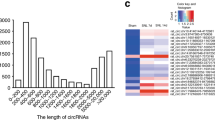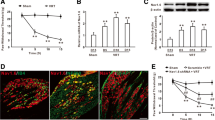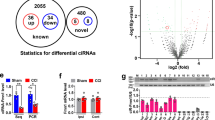Abstract
Effective treatments for neuropathic pain are lacking due to our limited understanding of the mechanisms. The circRNAs are mainly enriched in the central nervous system. However, their function in various physiological and pathological conditions have yet to be determined. Here, we identified circFhit, an exon-intron circRNA expressed in GABAergic neurons, which reduced the inhibitory synaptic transmission in the spinal dorsal horn to mediate spared nerve injury-induced neuropathic pain. Moreover, we found that circFhit decreased the expression of GAD65 and induced hyperexcitation in NK1R+ neurons by promoting the expression of its parental gene Fhit in cis. Mechanistically, circFhit was directly bound to the intronic region of Fhit, and formed a circFhit/HNRNPK complex to promote Pol II phosphorylation and H2B monoubiquitination by recruiting CDK9 and RNF40 to the Fhit intron. In summary, we revealed that the exon-intron circFhit contributes to GABAergic neuron-mediated NK1R+ neuronal hyperexcitation and neuropathic pain via regulating Fhit in cis.







Similar content being viewed by others
References
Hong JT, Kim JH, Kim KS, Lee CS, Shin HC, Kim WK. Pharmacological target therapy of neuropathic pain and patient-reported outcomes in patients with chronic low back pain in Korea: Results from the NLBP Outcomes Research. Medicine 2018, 97: e11919.
Binder A, Baron R. The pharmacological therapy of chronic neuropathic pain. Dtsch Arztebl Int 2016, 113: 616–625.
Ren WJ, Ulrich H, Semyanov A, Illes P, Tang Y. TASK-3: New target for pain-relief. Neurosci Bull 2020, 36: 951–954.
Szabo L, Salzman J. Detecting circular RNAs: Bioinformatic and experimental challenges. Nat Rev Genet 2016, 17: 679–692.
Jia RR, Xiao MS, Li ZG, Shan G, Huang C. Defining an evolutionarily conserved role of GW182 in circular RNA degradation. Cell Discov 2019, 5: 45.
Jeck WR, Sharpless NE. Detecting and characterizing circular RNAs. Nat Biotechnol 2014, 32: 453–461.
Zheng QP, Bao CY, Guo WJ, Li SY, Chen J, Chen B, et al. Circular RNA profiling reveals an abundant circHIPK3 that regulates cell growth by sponging multiple miRNAs. Nat Commun 2016, 7: 11215.
Ebbesen KK, Hansen TB, Kjems J. Insights into circular RNA biology. RNA Biol 2017, 14: 1035–1045.
Ma Y, Liu YX, Jiang ZS. CircRNAs: A new perspective of biomarkers in the nervous system. Biomed Pharmacother 2020, 128: 110251.
Pitcher MH, von Korff M, Bushnell MC, Porter L. Prevalence and profile of high-impact chronic pain in the United States. J Pain 2019, 20: 146–160.
Akhter R. Circular RNA and Alzheimer’s disease. Adv Exp Med Biol 2018, 1087: 239–243.
Zheng YL, Guo JB, Song G, Yang Z, Su X, Chen PJ, et al. The role of circular RNAs in neuropathic pain. Neurosci Biobehav Rev 2022, 132: 968–975.
Zhang SB, Lin SY, Liu M, Liu CC, Ding HH, Sun Y, et al. CircAnks1a in the spinal cord regulates hypersensitivity in a rodent model of neuropathic pain. Nat Commun 2019, 10: 4119.
Kujan O, Abuderman A, Al-Shawaf AZ. Immunohistochemical characterization of FHIT expression in normal human tissues. Interv Med Appl Sci 2016, 8: 7–13.
Trapasso F, Pichiorri F, Gaspari M, Palumbo T, Aqeilan RI, Gaudio E, et al. Fhit interaction with ferredoxin reductase triggers generation of reactive oxygen species and apoptosis of cancer cells. J Biol Chem 2017, 292: 14279.
Todd AJ. Neuronal circuitry for pain processing in the dorsal horn. Nat Rev Neurosci 2010, 11: 823–836.
Duan B, Cheng LZ, Ma QF. Spinal circuits transmitting mechanical pain and itch. Neurosci Bull 2018, 34: 186–193.
Peirs C, Seal RP. Neural circuits for pain: Recent advances and current views. Science 2016, 354: 578–584.
Leitner J, Westerholz S, Heinke B, Forsthuber L, Wunderbaldinger G, Jäger T, et al. Impaired excitatory drive to spinal GABAergic neurons of neuropathic mice. PLoS One 2013, 8: e73370.
Li CJ, Lei YY, Tian Y, Xu SQ, Shen XF, Wu HB, et al. The etiological contribution of GABAergic plasticity to the pathogenesis of neuropathic pain. Mol Pain 2019, 15: 1744806919847366.
Decosterd I, Woolf CJ. Spared nerve injury: An animal model of persistent peripheral neuropathic pain. Pain 2000, 87: 149–158.
Chaplan SR, Bach FW, Pogrel JW, Chung JM, Yaksh TL. Quantitative assessment of tactile allodynia in the rat paw. J Neurosci Methods 1994, 53: 55–63.
Ingolia NT, Ghaemmaghami S, Newman JRS, Weissman JS. Genome-wide analysis in vivo of translation with nucleotide resolution using ribosome profiling. Science 2009, 324: 218–223.
Koga M, Hayashi M, Kaida D. Splicing inhibition decreases phosphorylation level of Ser2 in Pol II CTD. Nucleic Acids Res 2015, 43: 8258–8267.
Sansó M, Parua PK, Pinto D, Svensson JP, Pagé V, Bitton DA, et al. Cdk9 and H2Bub1 signal to Clr6-CII/Rpd3S to suppress aberrant antisense transcription. Nucleic Acids Res 2020, 48: 7154–7168.
Xu YJ, Wu W, Han Q, Wang YL, Li CC, Zhang PP, et al. New insights into the interplay between non-coding RNAs and RNA-binding protein HnRNPK in regulating cellular functions. Cells 2019, 8: 62.
Cheng JX, Chen L, Li Y, Cloe A, Yue M, Wei JB, et al. RNA cytosine methylation and methyltransferases mediate chromatin organization and 5-azacytidine response and resistance in leukaemia. Nat Commun 2018, 9: 1163.
Xie WH, Nagarajan S, Baumgart SJ, Kosinsky RL, Najafova Z, Kari V, et al. RNF40 regulates gene expression in an epigenetic context-dependent manner. Genome Biol 2017, 18: 32.
Lee JT. Epigenetic regulation by long noncoding RNAs. Science 2012, 338: 1435–1439.
Ramírez-Jarquín UN, Tapia R. Excitatory and inhibitory neuronal circuits in the spinal cord and their role in the control of motor neuron function and degeneration. ACS Chem Neurosci 2018, 9: 211–216.
Ramírez-Jarquín UN, Lazo-Gómez R, Tovar-Y-Romo LB, Tapia R. Spinal inhibitory circuits and their role in motor neuron degeneration. Neuropharmacology 2014, 82: 101–107.
Baba H, Ji RR, Kohno T, Moore KA, Ataka T, Wakai A, et al. Removal of GABAergic inhibition facilitates polysynaptic A fiber-mediated excitatory transmission to the superficial spinal dorsal horn. Mol Cell Neurosci 2003, 24: 818–830.
Zhao P, Hou N, Lu Y. Fhit protein is preferentially expressed in the nucleus of monocyte-derived cells and its possible biological significance. Histol Histopathol 2006, 21: 915–923.
Rimessi A, Marchi S, Fotino C, Romagnoli A, Huebner K, Croce CM, et al. Intramitochondrial calcium regulation by the FHIT gene product sensitizes to apoptosis. Proc Natl Acad Sci U S A 2009, 106: 12753–12758.
Pulido M, Chamorro V, Romero I, Algarra I, S-Montalvo A, Collado A, et al. Restoration of MHC-I on tumor cells by fhit transfection promotes immune rejection and acts as an individualized immunotherapeutic vaccine. Cancers 2020, 12: 1563.
Goodrich JA, Kugel JF. Non-coding-RNA regulators of RNA polymerase II transcription. Nat Rev Mol Cell Biol 2006, 7: 612–616.
Geisler S, Coller J. RNA in unexpected places: Long non-coding RNA functions in diverse cellular contexts. Nat Rev Mol Cell Biol 2013, 14: 699–712.
Jonkers I, Lis JT. Getting up to speed with transcription elongation by RNA polymerase II. Nat Rev Mol Cell Biol 2015, 16: 167–177.
Jung I, Kim SK, Kim M, Han YM, Kim YS, Kim D, et al. H2B monoubiquitylation is a 5’-enriched active transcription mark and correlates with exon-intron structure in human cells. Genome Res 2012, 22: 1026–1035.
Acknowledgements
This work was supported by the National Natural Science Foundation of China (319700936, 81801103, 81901127, and 82101307), the Science and Technology Program of Guangdong (2018B030334001), the Natural Science Foundation of Guangdong (2019A1515010871, 2019A1515010645, and 2022A1515010414), the Guangzhou Science and Technology Plan Project (201803010006), the Natural Science Foundation of Jiangsu (BK20210904), and the Fundamental Research Funds for the Central Universities (19ykpy44). We thank Prof. Zhi-Cheng Dong for helping with the experiment on nuclear run-ons.
Author information
Authors and Affiliations
Corresponding authors
Ethics declarations
Conflict of interest
The authors declare that there are no conflict of interest.
Supplementary Information
Below is the link to the electronic supplementary material.
Rights and permissions
Springer Nature or its licensor (e.g. a society or other partner) holds exclusive rights to this article under a publishing agreement with the author(s) or other rightsholder(s); author self-archiving of the accepted manuscript version of this article is solely governed by the terms of such publishing agreement and applicable law.
About this article
Cite this article
Xu, T., Li, ZY., Liu, M. et al. CircFhit Modulates GABAergic Synaptic Transmission via Regulating the Parental Gene Fhit Expression in the Spinal Dorsal Horn in a Rat Model of Neuropathic Pain. Neurosci. Bull. 39, 947–961 (2023). https://doi.org/10.1007/s12264-022-01014-5
Received:
Accepted:
Published:
Issue Date:
DOI: https://doi.org/10.1007/s12264-022-01014-5




